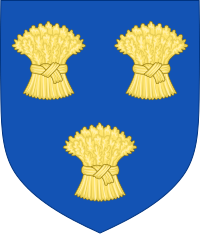
Back Граф Чэстэр Byelorussian Comtat de Chester Catalan Iarllaeth Caer Welsh Earl of Chester German Conde de Chester Spanish ارلنشین چستر Persian Comte de Chester French Razgovor:Erl Chestera Croatian Conte di Chester Italian チェスター伯 Japanese
This article needs additional citations for verification. (September 2022) |
| Earldom of Chester subsidiary of Principality of Wales since 1343 | |
|---|---|
 | |
| Creation date | 1067 (first creation) 1071 (second creation) 1254 (third creation) 1264 (fourth creation) 1301 (fifth creation) 1312 (sixth creation) see Prince of Wales for further creations |
| Created by | William the Conqueror (first creation) William the Conqueror (second creation) Henry III (third creation) Henry III (fourth creation) Edward I (fifth creation) Edward II (sixth creation) |
| Peerage | Peerage of the United Kingdom |
| First holder | Gerbod the Fleming, 1st Earl of Chester |
| Present holder | William, Prince of Wales[1] |
| Heir apparent | Non-Hereditary |
| Extinction date | 1070 (first creation) 1237 (second creation) 1272 (third creation) 1265 (fourth creation) 1307 (fifth creation) 1327 (sixth creation) |
| Former seat(s) | Chester Castle |
| Motto | Ich dien (I serve) |

The Earldom of Chester (Welsh: Iarllaeth Caer) was one of the most powerful earldoms in medieval England, extending principally over the counties of Cheshire and Flintshire. Since 1301 the title has generally been granted to heirs apparent to the English throne, and after 1707 the British throne. From the late 14th century, it has been given only in conjunction with that of Prince of Wales.
- ^ "Crown Office". The London Gazette. 24 February 2023. Retrieved 24 February 2023.
- ^ Tomlinson, H Ellis (1956). The Heraldry of Cheshire. Manchester: Manchester University Press. p. 159.